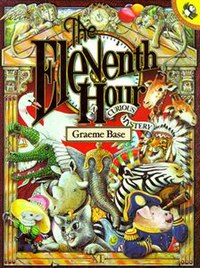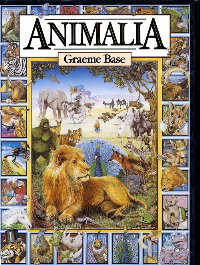
Animalia is an illustrated children's book by Graeme Base. It was originally published in 1986, followed by a tenth anniversary edition in 1996, and a 25th anniversary edition in 2012. Over four million copies have been sold worldwide. A special numbered and signed anniversary edition was also published in 1996, with an embossed gold jacket.

A crossword is a word puzzle that usually takes the form of a square or a rectangular grid of white-and black-shaded squares. The game's goal is to fill the white squares with letters, forming words or phrases, by solving clues, which lead to the answers. In languages that are written left-to-right, the answer words and phrases are placed in the grid from left to right and from top to bottom. The shaded squares are used to separate the words or phrases.
A cryptic crossword is a crossword puzzle in which each clue is a word puzzle in and of itself. Cryptic crosswords are particularly popular in the United Kingdom, where they originated, Ireland, Israel, the Netherlands, and in several Commonwealth nations, including Australia, Canada, India, Kenya, Malta, New Zealand, and South Africa. In the United States, cryptics are sometimes known as "British-style" crosswords. Compilers of cryptic crosswords are commonly called "setters" in the UK.

A cryptogram is a type of puzzle that consists of a short piece of encrypted text. Generally the cipher used to encrypt the text is simple enough that the cryptogram can be solved by hand. Frequently used are substitution ciphers where each letter is replaced by a different letter or number. To solve the puzzle, one must recover the original lettering. Though once used in more serious applications, they are now mainly printed for entertainment in newspapers and magazines.

Kryptos is a sculpture by the American artist Jim Sanborn located on the grounds of the Central Intelligence Agency (CIA) in Langley, Virginia. Since its dedication on November 3, 1990, there has been much speculation about the meaning of the four encrypted messages it bears. Of the four messages, the first three have been solved, while the fourth message remains as one of the most famous unsolved codes in the world. The sculpture continues to be of interest to cryptanalysts, both amateur and professional, who are attempting to decipher the fourth passage. The artist has so far given two clues to this passage.
The MIT Mystery Hunt is an annual puzzlehunt competition at the Massachusetts Institute of Technology. As one of the oldest and most complex puzzlehunts in the world, it attracts roughly 60 teams and 2,500 contestants annually in teams of 5 to 200 people. It has inspired similar competitions at Microsoft, Stanford University, Melbourne University, University of South Carolina, University of Illinois at Urbana–Champaign and University of Aveiro (Portugal) as well as in the Seattle, San Francisco, Miami, Washington, D.C., Indianapolis and Columbus, Ohio metropolitan areas. Because the puzzle solutions require knowledge of esoteric and eclectic topics, the hunt is often fused with popular stereotypes of MIT students.

The Fool's Errand is a 1987 computer game by Cliff Johnson. It is a meta-puzzle game with storytelling, visual puzzles and a cryptic treasure map. It is the tale of a wandering Fool who seeks his fortune in the Land of Tarot and braves the enchantments of the High Priestess.
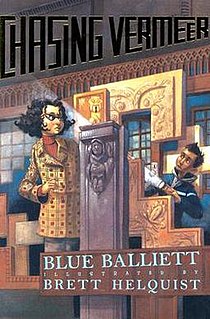
Chasing Vermeer is a 2004 children's art mystery novel written by Blue Balliett and illustrated by Brett Helquist. Set in Hyde Park, Chicago near the University of Chicago, the novel follows two children, Calder Pillay and Petra Andalee. After a famous Johannes Vermeer painting, A Lady In Writing, is stolen en route to the Art Institute of Chicago, Calder and Petra work together to try to recover it. The thief publishes many advertisements in the newspaper, explaining that he will give the painting back if the community can discover which paintings under Vermeer's name were really painted by him. This causes Petra, Calder, and the rest of Hyde Park to examine art more closely. Themes of art, chance, coincidence, deception, and problem-solving are apparent.

Masquerade is a picture book, written and illustrated by Kit Williams, published in August 1979, that sparked a treasure hunt by concealing clues to the location of a jewelled golden hare, created and hidden somewhere in Britain by Williams. The book became the inspiration for a genre of books known today as armchair treasure hunts.

A treasure hunt is one of many different types of games for players who try to find hidden objects or places by following a series of clues. Treasure hunt games may be an indoor or outdoor activity. Outdoors it can be played in a garden, indoors it can be played in a specific room, which would make the work of hiding the clues harder.
GAMES World Of Puzzles is a puzzle magazine formed from the merge of Games and World of Puzzles in October 2014.
The Clue series is a book series of 18 children's books published throughout the 1990s based on the board game Clue. The books are compilations of mini-mysteries that the reader must solve involving various crimes committed at the home of Reginald Boddy by six of his closest "friends".
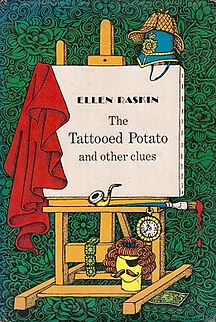
The Tattooed Potato and Other Clues is a children's novel by Ellen Raskin, published in 1975.
BBC MindGames was a British magazine devoted to puzzles, brainteasers and articles concerning the mind. It was published every four weeks. Its name was taken from the BBC Four show, Mind Games.

As Simple As Snow (2005) is a mystery novel by Gregory Galloway. It tells the story of a high-school aged narrator who meets a Gothic girl, Anna Cayne. Through postcards, a shortwave radio, various mix-CDs, and other erratic interests, Cayne eventually wins the heart of the narrator. However, a week before Valentine's Day, she goes missing, leaving only a dress on the ice and secret codes to help the narrator and the reader find out where she has gone.

Be An Interplanetary Spy is a series of twelve interactive children's science fiction books designed by Byron Preiss Visual Publications and first published by Bantam Books from 1983 to 1985.

The Clock Without a Face is puzzle book by Eli Horowitz and Mac Barnett with illustrations by Scott Teplin. It was published in 2010 by McSweeney's. The plot of the book revolves around the theft of 12 jeweled numbers from the face of "the Emerald Khroniker," a cursed clock, and with clues to the thief's identity and the whereabouts of the numbers are included throughout the text and in accompanying pictures. The identity of the thieves is revealed on the last page, but the location of the loot is not. The authors hid 12 actual emerald-studded numbers in locations around the United States, and readers are encouraged to search for them using the clues in the book.
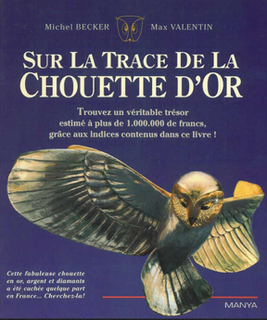
On The Trail Of The Golden Owl is a French armchair treasure hunt book, created by communications expert Régis Hauser under the pseudonym "Max Valentin", and by artist Michel Becker. The book provides clues to the location of a buried statuette of an owl, created by Becker. Hauser/Valentin died in 2009, the solutions are now held by his lawyer.

Cicada 3301 is a nickname given to an organization that on three occasions has posted a set of puzzles to recruit codebreakers/linguists from the public. The first internet puzzle started on January 4, 2012 and ran for approximately one month. A second round began one year later on January 4, 2013, and a third round following the confirmation of a fresh clue posted on Twitter on January 4, 2014. The stated intent was to recruit "intelligent individuals" by presenting a series of puzzles which were to be solved. No new puzzles were published on January 4, 2015. However, a new clue was posted on Twitter on January 5, 2016. In April 2017 a verified PGP-signed message was found: Beware false paths. Always verify PGP signature from 7A35090F. That message explicitly denies the validity of any unsigned puzzle, as recently as April 2017.
